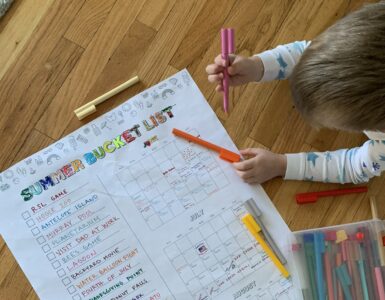Budgeting is a challenge for many families, but the key to being more successful might just be in opening more bank accounts. It’s easier to keep track of spending with more accounts.
Studio 5 Steals and Deals Contributor Jordan Page shares her reasons why everyone family should have 7 bank accounts.
When you file your important papers, you keep them all in the same filing cabinet. But are they in a big pile in the cabinet? No, they are in multiple filing folders to compartmentalize, manage, and organize your life, and to help you keep track of things you need.
So if your papers aren’t in one big drawer, why would you put all your money in one big bank account?
Most families have 1 savings account and 1 savings account. This is common, normal, and while it very well could work just fine for many families, MOST families statistically have trouble making and keeping a budget. I would like to propose a solution for helping to organize your money in an easy, effective way that will potentially save your family hundreds.
The “Lucky 7” Bank Accounts Every Family Should Have
Is having 7 bank accounts confusing or difficult? No! Whether your accounts are all with the same bank, or whether they are scattered across many banks, everything can be found online today which makes tracking your accounts very easy. I recommend using Mint.com. It’s a free online service that pulls information from every loan, credit card, and bank account you own, and puts it all onto one dashboard. You can see, in one spot, exactly what you need to see – regardless of how many accounts you have open, or how many banks you have accounts open in.
Many banks will actually PAY you to open a checking or savings account! Here’s how:
· You won’t find these deals online usually; you need to ask your local branch to put you on the mailing list to let you know when specials arise.
· ASK your favorite bank! Say, “Do you have any special incentives right now for opening an account through you rather than my going to your competitor?”
· Sign up for email lists. I get emails from Chase (my personal bank) all the time letting me know about promotions and deals.
Having only one or two bank account potentially makes for a harder time allocating and tracking expenses, and determining budgets. Here are 7 bank accounts to open that will help you organize your money:
1. Family emergency savings:
Purpose: For absolute, dire “we are going to lose our house next week if we don’t do something” emergencies.
Rules and tips:
Money should be automatically withdrawn from your paycheck every month (5%-10%) and deposited into this account. You should pretend that this money doesn’t exist when considering your income.
It needs to be an “out of sight, out of mind” account. Don’t even bring it up when calculating your money as a family, and NEVER consider it as an option for pulling money out of when needing to pay for something…unless it’s a literal life-or-death situation.
You can open this in any savings account, but I recommend opening this account through and online bank like ING or E*Trade because:
It’s much harder to withdraw money from (takes 3-5 business days to withdraw money from),
It’s “out of sight out of mind” because the balance isn’t easily seen along with your other accounts,
…And sometimes the interest is better.
How much to have in this account:
You should have enough to live on for 6 months (one year would be ideal).
You should put between 10% – 20% of your earnings every month into savings, so you want to divide that percentage into two savings accounts I am proposing; this one, and the Family Regular Savings account (see below).
Once that 6 month (or 1 year) goal has been met, the money can go toward the next savings account – but ideally you would never stop depositing into this account, even if you have to lower the percentage.
By having a Family Emergency Savings account that A) you automatically draft money to each month, and B) you NEVER pull money out of, you can effortlessly protect your family from the worst-of-the-worst circumstances.
2. Family regular savings:
Purpose: This is used for expenses you need/want to save up for – down payment on a house, new bedroom furniture, major home repairs, family vacation, new car, upcoming wedding, etc.
Rules and tips:
Money is automatically drafted from paychecks to this account every month (5%-10%).
This savings account can be at your normal bank. Try to find a bank that will pay you to open a savings account! You can get paid as much as $75-$150+, just read the fine print and make sure there are no hidden fees.
You need to have a plan for the money in this account! Don’t get in the habit of pulling money out of this account regularly – it needs to be for big purchases that require advance planning.
Save up the full amount before spending. Ex: If you are anticipating needing to take $2500 out for a new car, you need to have an excess of $2500 in the account to immediately make up for the difference before buying the new car.
How much to have in this account:
You need to save up the full amount for what you are about to purchase BEFORE buying it, so the total amount in this account will ebb and flow. However…
…You should, as a rule, always keep a balance of 3 months worth of living expenses in this account, so you can live off of it if needed for a short time before having to tap into your emergency savings.
By having a Family Regular Savings account you have a “holding account” delegated to hold larger sums of money which will help you save up for big expected or unexpected expenses, and protect your family in case you need to live off of savings for a short time.
3. Family checking:
Purpose: This is your “home base” account; the account where all paychecks/sources of income go initially. Your money starts here, then is transferred and allocated to other accounts. This is where you pay for minor car/home repairs, oil changes, utilities and all other bills (except for medical bills, more about this below), tithing/donations, and other “family” expenses.
Rules and tips:
All bills are paid from this account, preferably on auto-pay when possible to avoid late fees.
Money shouldn’t stay in this account for long, because it will be divided up and allocated to other accounts.
Try to streamline the allocating of this money to other accounts by setting them up on auto-transfer.
How much to have in this account:
Enough to cover all of your living expenses for the month, trying not to have excess leftover. Any excess needs to go to your savings accounts.
Just read the fine-print with your bank to make sure you don’t get slapped with any fees for not keeping a certain minimum amount in that account.
By having a Family Checking Account you have a “home base” account to hold all incoming money (that hasn’t been automatically distributed to savings accounts) for the month. It makes it easy and simple to see exactly how much money you need to cover all your spending in one month, making organizing money and allocating spending and budgets much easier.
4. Wife checking:
Purpose: The wife’s monthly budget drafts from the “family checking” account to this account every month. Everything she spends in the month gets paid for from this account.
Rules and Tips:
The wife uses this money to cover her budgeted expenses for the month, which needs to be determined in advance by each individual family.
If the wife stays home (for example), she will most likely be in charge of more expenses (or vice versa for the husband) Ex: grocery shopping, babysitting money, toiletries, home needs, piano lessons, pedicures, hair cuts, dog needs, school fees, etc.
Once the money has been deposited into the wife’s account, she can spend it however she wants. If she runs out of money before the end of the month, she needs to go without and spend more wisely next month.
These budgeted expenses can be described as things that this parent is regularly in charge of paying for. This would NOT include “family” expenses such as utility bills, home and car repairs, medical expenses, and large expenses like braces, new furniture, etc.
These budgeted expenses should be paid for each month preferably using a debit or credit card, which then gets paid off by the money in this account at the end of the month.
How much to have in this account:
Depends on your individual family situation…
…but only enough to cover the exact, full budget amount for the month. That way if the wife needs more money to pay for things, she can be held accountable for going over budget. On the flip-side, by having the exact amount in the account it’s easy to see when there is money leftover to go into the slush fund (see below).
A few guidelines for forming this budget:
Grocery budget should be $100 per family member, per month.
To calculate “other”, add up what the wife spent money on for the last 3 months that would apply within the bounds of her “spending responsibility”, divide it by 3 to find the average, then knock it down by at least 25%…because we usually spend more than we need to.
5. Husband checking:
Purpose: Same as wife checking. This is where the husband pays for his budgeted monthly expenses.
Rules and Tips:
The husband uses only this money to cover his budgeted expenses for the month, which needs to be determined in advance by each individual family. Ex: Eating out for lunch, golfing with the boys, date nights, getting his hair cut, etc.
All the same rules apply as with the wife checking account.
How much to have in this account:
Same rules apply as with wife checking.
By having Husband Checking and Wife Checking accounts this gives each parent autonomy to spend however they see fit while still being held accountable for the overall budget amount. It motivates them to be frugal where possible, because it allows for leftover money to go into the family Slush Fund (see below), or that money can be spent by them on something fun for themselves. These accounts help allocate spending responsibilities for a family, making “who is in charge of what” clear and concise, and makes setting and maintaining a family budget much easier.
6. HSA (Health Savings Account):
Purpose: This is a tax-free savings account built specifically to hold money to pay for any kind of medically-related expense, large or small.
Rules and Tips:
Go to www.healthcare.utah.edu to fully educate you on how these work.
HSA’s work best with more affordable, high-deductible accounts. With lower-deductible accounts, most of your money is going to a premium each month. You pay it, whether you use it that month or not. With a high-deductible plan, you pay for only what you use and still gives you protection for catastrophic events.
You will get an HSA debit card, this is what should be used to pay for EVERY medical expense – from a doctor’s office co-pay or prescription from a pharmacy, to having a baby or paying off surgery.
Why HSA vs a standard savings account? Any money deposited into an HSA is tax-free. For those who need a few thousand dollars a year (or more) to cover their family medical costs, this tax savings can be substantial.
“An HSA is all yours. Whatever you don’t spend stays there from year to year, earning interest tax-free. It’s yours even if you change jobs; and once you reach age 65, your HSA turns into a retirement account.
HSAs are available through banks, credit unions and insurance companies. Many employers now offer HSAs, as well. You may enroll in an HSA is you have an HDHP and no other health insurance. If you are enrolled in Medicare, you cannot contribute to an HSA, the Treasury Department says.
If you change jobs, your HSA goes with you. The money in your account earns tax-free interest, just like an IRA.
Young people in good health may benefit the most from an HSA, because they tend to have lower medical bills, and over many years the accumulated savings can be significant. Also, if you lose your job or are laid off and are collecting unemployment insurance, you can use your HSA funds to pay for routine health expenses and health insurance premiums, tax-free.
People who have lots of doctor office visits, such as families with small children or people with chronic health problems, often pay more out of pocket through an HSA than through a health maintenance organization.(healthcare.utah.edu)”
MAKE SURE to read the fine-print. Some HSA’s are “use it or lose it” accounts, or have fees attached. Both of these things are unnecessary.
How much to have in this account:
Some accounts have yearly maximums, so the account rules will decide how much you can have in there. Read the fine-print.
This is very personal based on your family situation. Ultimately you need to have enough to cover all perceived medical expenses for your family for the year, without depositing too much extra.
By having a Health Savings Account this keeps family savings accounts full and organized, and ensures sufficient funds to pay for medical expenses. It prevents having to dip into the Family Regular Savings account to pay off medical bills, and is a great solution for affordable healthcare. It helps you plan and prepare for expected and unexpected medical expenses, allows you to only pay for the healthcare you use and need, all while giving you tax-free savings.
7. “Slush Fund”:
Purpose: Optional 7th account. This is your 100% “fun money” account! This money does NOT go toward bills or “boring” things in any way…this is your reward for spending wisely and having money leftover from budgets at the end of the month, and for being out of debt. The money should be spent on something “fun” that you might not choose to (or be able to) spend money on otherwise.
Rules and Tips:
You need a plan for this money. It could be for a new TV, vacation, a trampoline, or something else fun that your budget might not allow for otherwise.
Get your family involved on this goal. Have it be a community fund where any extra money gets contributed toward a common, exciting goal. Make a chart for your fridge, or put pennies in a jar to represent every dollar put in the account. Make it visual, fun, and exciting for the family.
You should only put money toward a slush fund if debt is paid off (debt such as credit cards, student loans, and outstanding bills).
How much to have in this account:
This depends on how conservative you are with your spending! This account only holds EXTRA, un-spent funds. The less you spend throughout the month, the more you will have in this account.
This may build up very slowly. It may be as simple as $10 leftover in a grocery budget from the week, or $100 of a tax return that wasn’t needed for other accounts, or leftover birthday money that a child wants to contribute.
Setting a goal for this money is key, so you know how much you need to have in this account before spending it.
By having a Slush Fund Account this encourages a united excitement for spending wisely as a family. It gives everyone a common goal to work for, and allows for a family to spend money on something 100% fun that they might not be able to spend money on otherwise. It encourages saving, budgeting, and delayed gratification.
So, rather than tossing all of your money in to one savings and one checking account, try opening these 7 accounts. It may be just the step your family needs to get your budgeting and spending on-track!















Add comment